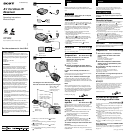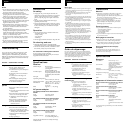
Notes
• Do not block the space between the receivers IR
sensor and the camcorder’s transmitter. If you do
the picture and sound will not function.
• The infrared rays will not penetrate walls or
opaque glass, the infrared receiver must be used
within the “in sight” area of the camcorder.
• Do not position the camcorder and receiver too
close. Noise and beats will appear as a result.
• Do not use this unit in combination with cordless
headphones or another unit of the same type.
Signal cancellation will result.
• The brightness of the camcorder’s infrared ray
emitter is not necessarily stabilized. This is not a
malfunction and does not affect the infrared
coverage distance.
• Be sure that no strong light sources such as direct
sunlight, inverter light, or powerful remote
signals block the path of the IR sensor on the
receiver. If it does the picture and sound will not
function, or distortion may result.
• Do not use in areas of strong electrical currents
or radio waves. If you do clear playback is not
possible.
• Do not use near a AM radio or tuner. If you do
radio or tuner interference will result.
• During use the unit will heat up, this is normal.
Troubleshooting
If you run into any problem using the unit, first
check the power supply source. Then use the
following table for troubleshooting. Should the
difficulty persist disconnect the power source and
contact your Sony dealer or local authorized Sony
service facility.
Trouble Cause and/or remedy
No picture and no sound at all
•The AC power adaptor is not
connected to an AC outlet.
b Connect the AC power adaptor to
an AC outlet.
•Connecting cord is not connected
correctly.
b Connect the connecting cord
correctly.
•Direct sunlight is shining on the
infrared sensor of the receiver.
b Avoid direct sunlight.
The infrared transmission system does not
operate
•The power of the receiver is turned
off (OFF).
b Press the power button to turn the
receiver (ON).
•The camcorder’s transmitter and the
receiver are not facing each other.
b Adjust the position and angle of
both units.
•The receiver is positioned too far
from the camcorder’s transmitter.
b Use the transmitter near the
infrared receiver.
Background noise and unclear picture
•The camcorder’s transmitter and
receiver are not facing each other.
b Adjust the position and angle and
unclear picture of both units.
•Another infrared emitting appliance
is operating.
b Stop operating it.
Precautions
On safety
• Unplug the AC power adaptor from the AC
outlet when it will not be used for a long period
of time. To disconnect the AC power adaptor,
pull it out by the plug. Never pull on the cord
itself.
• Do not open the cabinet. Refer servicing to
qualified personnel only.
• Be sure that nothing metallic comes into contact
with the metal parts of the AC power adaptor. If
it does a short may occur and the unit may be
damaged.
Operation
• Do not place the unit in a location where it is:
– Extremely hot or cold
– Dusty or dirty
– Very humid
– Vibrating
• Do not apply mechanical shock or drop the unit.
On cleaning and care
• Clean the cabinet with a soft cloth slightly
moistened with water or mild detergent solution.
• Do not use alcohol, benzene, or thinner to clean
the cabinet, as they may mar the finish.
For customers in European countries
If your TV has a 21-pin connector
(EUROCONNECTOR), use the 21-pin connector
supplied with the camcorder.
Specifications
Receiver
VIDEO output Phono jack (1)
1 Vp-p, 75 ohms unbalanced,
sync negative
(when POWER is ON)
AUDIO output Phono jacks (2:L,R): 327 mV,
output impedance: less than
2.2 kilohms (when POWER
is ON)
DC input DC 6V
Operating temperature
32°F to 104°F (0°C to 40°C)
Storage temperature –4°F to 140°F (–20°C to 60°C)
Dimensions Approx. 4
4
/
5
× 1
5
/
8
× 5
1
/
5
inches (121 × 41 × 128 mm)
(w/h/d)
Mass Approx. 6
1
/
2
oz (185 g)
AC power adaptor
For models purchased in the United States or
Canada
Input AC 120 V 60 Hz
Output DC 6 V 400 mA
For models purchased in the United Kingdom
Input AC 220-230 V 50/60 Hz
Output DC 6 V 700 mA
For models purchased in other European
countries
Input AC 220-230 V 50 Hz
Output DC 6 V 400 m
For models purchased in the Australia
Input AC 240 V 50 Hz
Output DC 6 V 700 mA
Supplied accessory AC power adaptor (1)
A/V connecting cable (1)
Design and specifications are subject to change
without notice.
English Français
Remarques
• Ne pas obstruer l’espace entre le capteur infrarouge du
récepteur et l’émetteur du camescope, sinon l’image et le
son n’apparaîtront pas.
• Les rayons infrarouges ne traversent pas les murs ni le
verre opaque. Le récepteur doit être “en vue” du
camescope.
• Ne pas trop rapprocher le camescope du récepteur. Des
parasites et battements apparaissent quand le récepteur
et le camescope sont trop rapprochés.
• Ne pas utiliser le récepteur avec un casque sans fil ou
tout autre appareil de même type. Les signaux risquent
de s’annuler.
• La luminosité de l’émetteur du camescope de rayons
infrarouges n’est pas forcément stable. Il ne s’agit pas
d’un mauvais fonctionnement et la portée des rayons
infrarouges n’en est pas affectée.
• Assurez-vous qu’aucune source de lumière puissante,
soleil, lampe à circuit inverseur, signaux de
télécommande puissants, etc. ne bloquent les signaux
infrarouges envoyés par le récepteur, sinon l’image et le
son n’apparaîtront pas, ou ils présenteront de la
distorsion.
• Ne pas utiliser le récepteur dans les endroits exposés à
des courants électriques puissants ou aux ondes radio,
car il ne sera pas possible d’obtenir une lecture claire.
• Ne pas utiliser près d’une station radio AM ou d’un
tuner, sinon des interférences perturberont la réception
radio ou le tuner.
• Le récepteur chauffe quand il est allumé, mais c’est tout
à fait normal.
Guide de dépannage
En cas de problème, vérifiez la source d’alimentation et
reportez-vous au tableau suivant pour essayer de trouver
l’origine du problème. Si la difficulté persiste, malgré les
vérifications suivantes, débranchez le récepteur de la
source d’alimentation et contactez votre revendeur Sony
ou un centre de réparations agréé Sony.
Problème Causes et ou remèdes
Aucune image ni aucun son.
• L’adaptateur d’alimentation secteur n’est
pas branché sur une prise secteur.
bRaccordez-le à une prise secteur.
• Le cordon de liaison n’est pas
correctement raccordé.
bRaccordez-le correctement.
• La lumière du soleil atteint le capteur
infrarouge du récepteur.
bÉvitez d’installer le récepteur en plein
soleil.
Le système de transmission infrarouge ne
fonctionne pas.
• Le récepteur est éteint (OFF).
bAppuyez sur l’interrupteur
d’alimentation pour allumer le
récepteur (ON).
• L’émetteur du camescope et le capteur du
récepteur ne sont pas face à face.
bAjustez la position et l’angle des deux
appareils.
• Le récepteur est trop loin de l’émetteur du
camescope.
bRapprochez le camescope du récepteur.
Bruit de fond et image floue.
• L’émetteur du camescope et le capteur du
récepteur ne sont pas face à face.
bAjustez la position et l’angle des deux
appareils.
• Un autre appareil émettant des rayons
infrarouges est utilisé.
bÉteignez cet appareil.
Précautions
Sécurité
• Débranchez l’adaptateur d’alimentation secteur de la
prise murale si vous prévoyez de ne pas l’utiliser
pendant longtemps. Pour débrancher l’adaptateur, tirez
sur la prise. Ne jamais tirer sur le cordon.
• Ne pas ouvrir le coffret. Pour toute réparation, faites
appel à un professionnel seulement.
• Veillez à ce qu’aucun objet métallique ne touche les
parties métalliques de l’adaptateur. Il pourrait être
endommagé par un court-circuit.
Fonctionnement
• Ne pas installer le récepteur dans un endroit exposé:
– à des températures extrêmes
– à une poussière extrême
– à une humidité extrême
– à des vibrations
• Ne pas soumettre le récepteur à des chocs mécaniques et
ne pas le laisser tomber.
Nettoyage et entretien
• Nettoyez le coffret avec un chiffon doux légèrement
mouillé d’eau ou d’une solution détergente neutre.
• Ne pas utiliser d’alcool ni de diluant pour nettoyer le
coffret, car ils pourraient endommager la finition.
Pour les utilisateurs dans les pays
européens
Si votre téléviseur a une prise de péritélévision à 21
broches (Euroconnecteur), utilisez le connecteur à 21
broches livré avec le camescope.
Spécifications
Récepteur
Sortie VIDEO Prise cinch (1): 1 Vc-c
75 ohms, asymétrique, sync.
négative (sous tension)
Sortie AUDIO Prises cinch (2: gauche et
droite): 327 mV,
impédance de sortie: inférieure
à 2,2 kilohms (sous tension)
Entrée DC DC 6 V
Température de fonctionnement
32°F à 104°F (0°C à 40°C)
Température d’entreposage
–4°F à 140°F (–20°C à 60°C)
Dimensions Env. 4
4
/
5
× 1
5
/
8
× 5
1
/
5
pouces
(121 × 41 × 128 mm)
(l/h/p)
Poids Env. 6,5 on. (185 g)
Adaptateur d’alimentation secteur
Pour les modèles achetés aux Etats-Unis ou au Canada
Entrée Secteur 120 V, 60 Hz
Sortie CC 6 V, 400 mA
pour les modèles achetés au Royaume-Uni
Entrée Secteur 220-230 V, 50/60 Hz
Sortie CC 6 V, 700 mA
Pour les modèles achetés dans d’autres pays d’Europe
Entrée Secteur 220-230 V, 50 Hz
Sortie CC 6 V, 400 mA
Pour les modèles achetés en Australie
Entrée Secteur 240 V, 50 Hz
Sortie CC 6 V, 700 mA
Accessoire fourni Adaptateur d’alimentation
secteur (1)
Cordon de liaison audio/vidéo
(1)
La conception et les spécifications peuvent être modifiées
sans préavis.




